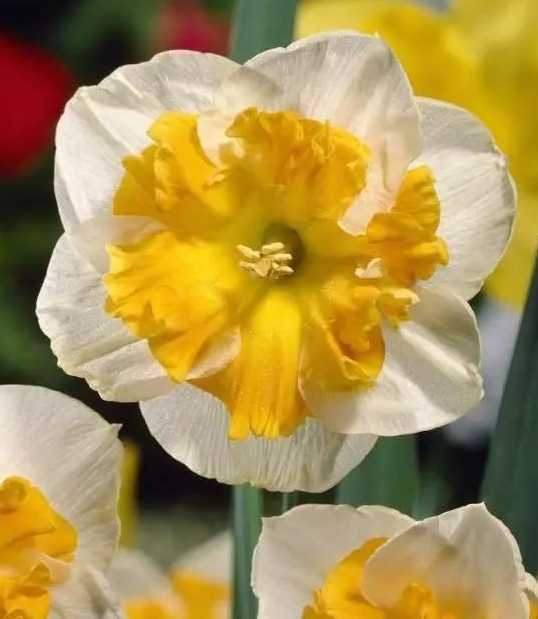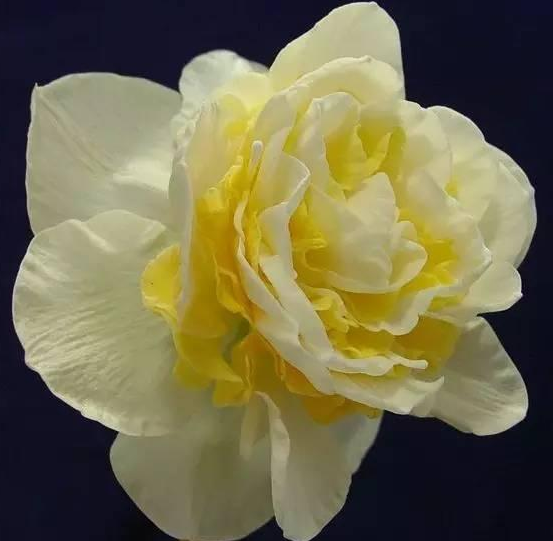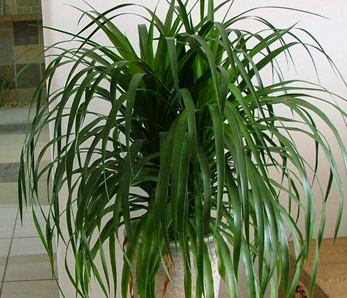How to lengthen the florescence of daffodils by soil culture
To talk about this daffodil, it is very good-looking, especially when it is in bloom, let's take a look at the appearance of daffodils. How to make the florescence of daffodils longer?

Soil culture of daffodils:
It is seldom used by families, that is, the cultivation of daffodils by using most moist soil flowers. In mid-late October, large bulbs were planted in small porous flowerpots with fertile sandy soil, half exposed, and some fine sand should be padded under the scales to facilitate drainage.
Put the flowerpot in the room with plenty of sunshine and suitable temperature.
It is better to take 4 to 12 ℃, too low temperature is easy to cause frost injury, too high temperature and lack of light, easy to steep long, thin plants, short flowering time, reduce the ornamental value.
If the requirements of light and temperature are met in the management, the leaves will be enlarged and the flowers will be stout, thus making the flowers bloom large and fragrant for a long time. If you cultivate daffodils in soil, you can apply liquid fertilizer two or three times before flowering.
Daffodils cannot reproduce on their own because of limited climatic conditions. The cultivation of daffodils, if there is no harm to diseases and insect pests, do not need to be sprayed.
A way to lengthen the flowering period of daffodils:
When the room temperature is ≥ 13 ℃, the florescence is only about 7 days.
At 8: 12 ℃, the florescence can be as long as 15 to 20 days.
The florescence lasts for 10 days at 15: 20 ℃.
If the room temperature is kept at about 4 ℃, the flowering period can be as long as 1 month. According to the temperature conditions in the Pearl River Delta region, the general florescence can be maintained for 10 days.
This is the end of the soil culture methods of daffodils, so don't hurry to use these methods to make the flowering period of daffodils longer.
The method of hydroponic culture of daffodils the conservation of daffodils
Daffodils have a wide range of varieties and colors, beautiful colors and pleasant fragrance. Many people like to carry out indoor hydroponic culture, which is very ornamental. So, how do daffodils grow hydroponically? How to maintain it? Next, I will introduce the hydroponic culture methods of daffodils, as well as the maintenance of daffodils.
Methods of hydroponic culture of daffodils
1. Selection of daffodil bulbs
To choose a large number of flower buds, it is best to have a flat, round, solid and large one with a diameter above 8cm, and press on both sides of the sphere, with a column inside and a solid brown seed ball.
2. Cleaning of daffodil bulbs
Remove the brown coating, protective mud and brown rotten roots on the outside of the bulb, cut 2-3cm vertically on both sides of the top of the daffodil ball, with a depth of 1 3cm, cut only the bulbs and do not hurt the young leaf buds. Then sprinkle carbendazim in the water, soak the daffodils for a day and night, and then wash the mucus from the daffodils.
3. Maintenance of daffodil bulbs
Put the seed ball into a hydroponic vessel and add clean water. It is advisable to use quartz sand or pebbles to fix the seed ball. During the maintenance of daffodils, sufficient light can make the leaf buds of daffodils thick and sturdy, and the leaf color thick green. Therefore, it is appropriate to put it in a sunlit place during the day and under the light at night.
Just into the basin hydroponics, the need to change water every day, the next 2-3 days to change once, after the formation of the bud, can be changed once a week, daffodils grow well in 10-15 degrees environment. If you want to postpone flowering, you can lower the water temperature, or pour out the basin in the evening, and then add fresh water the next day. On the contrary, the water temperature can be increased to promote flowering, and the water temperature should be 15 degrees.
Flower fertilizer may not be applied during the maintenance of daffodils. During flowering, some available phosphate fertilizer can be applied to make the flowers bloom better. When the flowers are all in full bloom, a small amount of salt can be put into the pot to prolong the flowering period. Do not put salt in the bud of Narcissus, which will restrain the opening of Narcissus.
Maintenance of daffodils
Aspirin can help daffodils bloom
Use 1 to 2 aspirin tablets and dissolve them thoroughly in water to replace the water in the daffodil pot to make the flowers stronger and luxuriant.
2. Narcissus warming up to promote flowering
Daffodils grow slowly at low temperatures, and can be induced to blossom by warming:
Sun warming: transfer to outdoor sunlight during the day, or in front of sunny windows facing south indoors, until flowering.
Lighting warming: cover the flowerpot with a plastic cover, turn on the light, and wait for the cover to heat up to 23 ℃.
Electric heater heating: turn on the electric heater or place the hair dryer in a position not to scald the daffodils and let the warm wind slowly blow the flowers for several days until the flowers bloom.
Warm water: put a small amount of warm water in the basin to raise the water temperature to 12: 15 ℃.
3. Salt prolongs the period of daffodils.
When the daffodils are all in full bloom, put a small amount of salt into the basin to prolong the flowering period. Do not put salt when the daffodils are budding, otherwise it will inhibit the opening of the buds.
Or grind two aspirins into powder, put them in 1000 milliliters of water, dissolve and sprinkle them in the blooming daffodils basin, which can prolong the daffodil blooming period by about a week.
4. Brightening method
When the daffodils grow to a height of about 25 cm, the aqueous solution of food pigment steamed from pastry is injected into the stem with a medical syringe, and the injection point is the upper 1cm of the stem height.
5. Prevent rotting roots.
First of all, if the water is empty at night, the roots will not dry up. The hair root is yellow and soft: change the water frequently. To keep the water clean, daffodils had better change the water every 3 days to prevent root rot. Soft toothbrushes can be used for yellowing.
The above is for everyone to introduce the hydroponic culture methods of daffodils, as well as the maintenance of daffodils, are we clear? Please pay attention to more household knowledge.
[hydroponic daffodils] Culture methods and matters needing attention of hydroponic daffodils
Hydroponically cultured daffodils, the engraved daffodils are placed upright or lying flat into a shallow basin of daffodils, and 1/3 of the bulbs are submerged with water. The bulb can be fixed with quartz sand and pebbles in the basin. The following is a detailed introduction of daffodils culture methods.
Culture methods of hydroponic daffodils 1. Selection of daffodil bulbs
To choose a large number of flower buds, it is best to have a flat, round, solid and large one with a diameter above 8cm, and press on both sides of the sphere, with a column inside and a solid brown seed ball.
2. Cleaning of daffodil bulbs
Remove the brown coating, protective mud and brown rotten roots on the outside of the bulb, cut 2-3cm vertically on both sides of the top of the daffodil ball, with a depth of 1 3cm, cut only the bulbs and do not hurt the young leaf buds. Then sprinkle carbendazim in the water, soak the daffodils for a day and night, and then wash the mucus from the daffodils.
3. Maintenance of daffodil bulbs
Put the seed ball into a hydroponic vessel and add clean water. It is advisable to use quartz sand or pebbles to fix the seed ball. During the maintenance of daffodils, sufficient light can make the leaf buds of daffodils thick and sturdy, and the leaf color thick green. Therefore, it is appropriate to put it in a sunlit place during the day and under the light at night.
4. Use good water
It is best to grow daffodils with clean spring water, well water, Rain Water or river water. It is necessary to insist on changing the water once a day or two, and do not hurt the root when changing the water. because a large amount of nutrients have been stored in the daffodil bulb, there is no need to topdressing during hydroponic culture.
5. Temperature control
The suitable temperature of Narcissus is 10 ℃ ~ 18 ℃, the relative humidity is 85% and 95%, and it can withstand 0 ℃ low temperature. If you want to postpone flowering, you can lower the water temperature, or pour out the basin in the evening, and then add fresh water the next day. On the contrary, the water temperature can be increased to promote flowering, and the water temperature should be 15 degrees.
6. Fertilization awareness
Flower fertilizer may not be applied during the maintenance of daffodils. During flowering, some available phosphate fertilizer can be applied to make the flowers bloom better. When the flowers are all in full bloom, a small amount of salt can be put into the pot to prolong the flowering period. Do not put salt in the bud of Narcissus, which will restrain the opening of Narcissus.
7. Maintenance methods of hydroponic daffodils.
When there is plenty of sunshine during the day, it should be placed in the sunny place and put back in the house at night. (it is important to pour all the water out of the basin to control the growth of the leaves. Add fresh water the next morning, and remember not to move the bulb.
At the beginning of the basin, the daffodils should change the water once a day, and then change it in 2-3 days. When she forms a bud, she can be watered once a week. Let the daffodils bloom in about 45 days, so that the flowering period can be maintained for more than a month.
The advantages of hydroponic daffodils
1, water to raise daffodils, generally do not need fertilization, only water can be used. If there are conditions, if you apply some available phosphate fertilizer during flowering, the flowers can bloom better.
2. If you want to postpone the florescence, you can take the method of lowering the water temperature, or pour out the basin water in the evening and add fresh water the next morning. In addition, if the full bud is not seen 10 days before the festival, the method of heating the water supply can be used to promote the flower, and the water temperature should be close to the body temperature.
Matters needing attention in hydroponic daffodils 1. Prevention of "dumb flowers"
The daffodil ball is of poor quality, weak physique, small sphere and improper maintenance. Poor ventilation, lack of light, water discomfort, etc.; improper water season, water culture after the temperature rises; note that if you use tap water to grow flowers, the water should be placed one day in advance before use.
2. Control florescence
Water raised in autumn and winter, blooming in spring, about 40-45 days.
3. To prevent excessive growth
When raising in water, remove the brown capsule, cut the knife vertically and horizontally on the daffodil ball, and put it into a shallow basin for cultivation. (remember not to hurt flower buds) get enough light to avoid overgrowing leaves.
4. Narcissus is poisonous.
The root, stem and leaf flowers of daffodils are poisonous, so don't let children touch or even gnaw them.
- Prev

Hydroponic culture of daffodils whether to blossom in winter and how to control the flowering time
To talk about this daffodil, it is also very good-looking, many people like it very much, daffodils can be hydroponic, but also can be cultivated in soil, let's take a look at the hydroponic method of daffodils. Do daffodils bloom in winter? How to control the flowering time of daffodils: hydroponic culture method of daffodils: shallow basin immersion method
- Next

How to raise the sword leaf dragon blood tree? can it be inserted alive?
When it comes to this sword-leaf dragon blood tree, it is very good-looking and suitable for viewing leaves. It is so green all the year round. Let's take a look at how to raise the sword-leaf dragon blood tree. Sword leaf dragon blood tree can be inserted alive: how to raise the sword leaf dragon blood tree: 1. Temperature: the most suitable growth temperature for the sword leaf dragon blood tree is 20-28 ℃
Related
- Fuxing push coffee new agricultural production and marketing class: lack of small-scale processing plants
- Jujube rice field leisure farm deep ploughing Yilan for five years to create a space for organic food and play
- Nongyu Farm-A trial of organic papaya for brave women with advanced technology
- Four points for attention in the prevention and control of diseases and insect pests of edible fungi
- How to add nutrient solution to Edible Fungi
- Is there any good way to control edible fungus mites?
- Open Inoculation Technology of Edible Fungi
- Is there any clever way to use fertilizer for edible fungus in winter?
- What agents are used to kill the pathogens of edible fungi in the mushroom shed?
- Rapid drying of Edible Fungi

